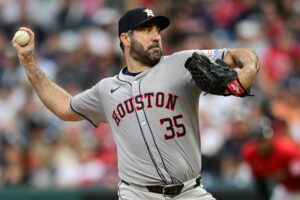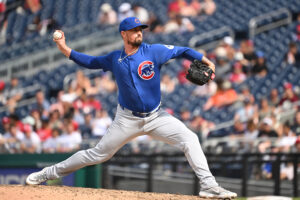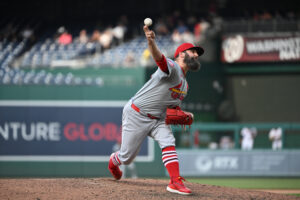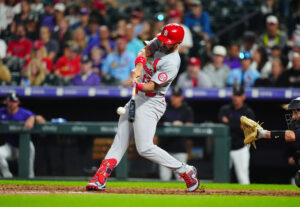Arizona Diamondbacks All-Decade Team: Position Players
The Arizona Diamondbacks had a decade of ups and downs. They had four losing seasons, two .500 seasons, and four winning seasons. Two seasons resulted in playoff berths – one as a division champion (2011) and one as the Wild Card (2017). They have had tremendous players come through, so the Diamondbacks All-Decade Team for the 2010s is a force to be reckoned with.
The 25-man All-Decade team has eight starting position players. There are five reserves – a catcher, two infielders, and two outfielders. A five-man starting rotation and a seven-man relief corps fills out the rest.
Selection Process
The selection method for position players takes statistics from FanGraphs. It uses their statistic of weighted On Base Average (wOBA), created to correct the flaws of OPS (On-base Plus Slugging), to determine weighted Runs Above Average (wRAA). The calculation method is here, but in summary, it determines how many more runs a team scored by having that player rather than the average hitter from the league that season. A player’s wRAA is then added to his Baserunning Rating (BsR) and his defensive rating (Def), both from FanGraphs, to determine his overall rating. Without further ado, here are the position players from the Diamondbacks All-Decade Team for the 2010s.
Diamondbacks All-Decade Starting Infield
Catcher – Miguel Montero (2011)
This wasn’t a case of who the catcher would be but which season from Miguel Montero to use. Of the top five catcher ratings in the decade, Montero had four of them, including each of the top three. His best season came in 2011. That year, he batted .282 (139 for 493) with 36 doubles, a triple, 18 home runs, 86 RBI, and 65 runs scored in 140 games. This gave him a wRAA of 16.0. His BsR – something that is never high for a catcher – was -6.2, but his defensive rating was staggering – 34.0. This gave him a total of 43.8. Some of his high defensive rating stemmed from him throwing out 40% of all would-be base stealers that season, tops in the National League. In 2011, he made the All-Star team and was a key piece of the team that won the National League West.
First Baseman – Paul Goldschmidt (2015)
The top seven seasons by a first baseman all came from Paul Goldschmidt, and his rookie season (2011) was the ninth-best season. Like Montero, but to a higher degree, the question was which season to use. His best year came in 2015, when he made the All-Star team en route to a Gold Glove, Silver Slugger Award, and a second-place finish in the MVP voting. In that season, he batted .321 (182 for 567) with 38 doubles, two triples, 33 home runs, 110 RBI, 21 stolen bases in 26 attempts, 118 walks (29 intentional, tops in the majors), and 103 runs scored in 159 games. This gave him an insane wRAA of 57.9. That, added to his 3.0 BsR and -7.5 Def, gave him an overall rating of 53.4. For comparison, the next first baseman on the list – the 2019 version of Christian Walker – had a total rating of 7.6.
Second Baseman – Kelly Johnson (2010)
The Diamondbacks had a case of “their cup runneth over” at second baseman in the 2010s. Four players had a total rating greater than 30, with one – Ketel Marte (2019) — having a rating of 57.0. Since Marte also played center field in 2019, he is being used there. That brings up the next player on the list – Kelly Johnson, whose 2010 season rated 38.5. In that year, Johnson batted .284 (166 for 585) with 36 doubles, five triples, 26 home runs, 71 RBI, 13 stolen bases in 20 attempts, 79 walks, and 93 runs scored in 154 games. That game him a wRAA rating of 30.8 to go along with a -1.8 BsR and 9.5 Def.
Shortstop – Stephen Drew (2010)
Stephen Drew had far and away the best season of the decade by a Diamondbacks shortstop. In 2010, he hit .278 (157 for 565) with 33 doubles, 12 triples, 15 home runs, 61 RBI, 10 stolen bases in 15 attempts, 62 walks, and 83 runs scored in 151 games. This gave him a wRAA of 17.3, along with a 1.5 BsR and a 15.4 Def for a total rating of 34.2. The next guy on the list – the 2019 version of Nick Ahmed – had a total rating of 8.4.
Third Baseman – Ryan Roberts (2011)
This was a tight battle between the 2011 version of Ryan Roberts and the 2019 version of Eduardo Escobar. Offensively, Escobar had the edge. Roberts batted .249 (120 for 482) with 25 doubles, two triples, 19 home runs, 65 RBI, 18 stolen bases in 27 attempts, 66 walks, and 86 runs scored in 143 games. Escobar, meanwhile, batted .269 (171 for 636) with 29 doubles, 10 triples, 35 home runs, 118 RBI, five stolen bases in six attempts, 50 walks, and 94 runs scored in 158 games. This gave Roberts a wRAA of 10.0 and Escobar a wRAA of 12.8. Their BsR ratings – 1.9 and 2.9, respectively – gave Roberts an offensive rating of 11.9 and Escobar 15.7. What gives Roberts the edge is defense. His rating was 9.3, while Escobar’s was 3.9. That gave Roberts a total rating of 21.2 and Escobar a total of 19.6.
Diamondbacks All-Decade Starting Outfield
Left Field – David Peralta (2015)
The best season by a Diamondbacks left fielder came from David Peralta in 2015, his second year in the league. That year, he hit .312 (144 for 462) with 26 doubles, 10 triples, 17 home runs, 78 RBI, nine stolen bases in thirteen attempts, 44 walks, and 61 runs scored in 149 games. This gave him 27.5 wRAA and 3.5 BsR. Combined with a -4.9 Def rating, this gave him a total rating of 26.1. Peralta also had the next-best rating, 22.3, in 2018. The next player on the list after those two Peralta seasons was the 2011 version of the Baby Shark himself, Gerardo Parra, who rated 13.8.
Center Field – Ketel Marte (2019)
Ketel Marte’s selection here was interesting, given that he was the starting second baseman for the National League at the 2019 All-Star Game. However, he also played center field, and his numbers compared with the other outfielders forced a lineup decision based on the backups. Anyway, his 2019 season was phenomenal. He batted .329 (187 for 569) with 36 doubles, nine triples, 32 home runs, 92 RBI, 10 stolen bases in 12 attempts, 53 walks, and 97 runs scored in 144 games. This gave him an impressive .405 wOBA, good enough for 46.1 wRAA. Added to his 4.2 BsR and 6.7 Def, that gives him a total rating of 57.0.
Right Field – Justin Upton (2011)
Justin Upton won the Silver Slugger during his All-Star season in 2011, finishing fourth in the National League MVP vote. He batted .289 (171 for 592) with 39 doubles, five triples, 31 home runs, 88 RBI, 21 stolen bases in 30 attempts, 59 walks, 19 times hit by a pitch (tops in the NL), and 105 runs scored in 159 games. That gave him a .385 wOBA, 36.9 wRAA, and a 6.6 BsR. Adding the wRAA and BsR to his 0.9 Defensive Rating gives him a total of 44.4. That put him well ahead of the second-place man on the list, the 2017 version of J.D. Martinez (17.3 rating).
Diamondbacks All-Decade Reserves
Catcher – Chris Iannetta (2017)
Chris Iannetta had the highest rating of people not named “Montero,” finishing fourth on the list. During the 2017 season where the Diamondbacks won the Wild Card, he batted .254 (69 for 272) with 19 doubles, 17 home runs, 43 RBI, 37 walks, and 38 runs scored in 89 games. This gave Iannetta 12.3 wRAA. Combining that with his -2.6 BsR and 6.8 Def gives him a total rating of 16.5.
Infielders – Jean Segura (2016) and Eduardo Escobar (2019)
Jean Segura had a tremendous season while playing second base in 2016, batting .319 (203 for 637) with 203 hits, 41 doubles, seven triples, 20 home runs, 64 RBI, 33 stolen bases in 43 attempts, 39 walks, and 102 runs scored in 153 games. These numbers translated into 30.4 wRAA and a BsR of 5.0. Adding those numbers to his 0.3 Def rating gives a total rating of 35.7, the highest for a non-starting infielder.
The next highest rating went to the 2012 edition of Aaron Hill (.302 (184 for 609), 44 2B, 6 3B, 26 HR, 85 RBI, 14 SB in 19 tries, 52 BB, 32.4 wRAA, 0.6 BsR, 1.0 Def, 34.0 Total rating). However, having two second basemen as reserves made no sense, so instead, the second reserve infielder spot went to this year’s edition of Escobar. His statistics are under the starting third baseman spot.
Outfielders – A.J. Pollock (2015) and Chris Young (2011)
In 2015, A.J. Pollock had his breakout year. So far it has been the best of his career, and it earned him his only All-Star selection and only Gold Glove. He batted .315 (192 for 609) with 39 doubles, six triples, 20 home runs, 76 RBI, 39 stolen bases in 46 attempts, 53 walks, and 111 runs scored in 157 games. It translated into 31.0 wRAA and a 6.7 BsR. When added to his 11.9 Def rating, it made a total rating of 49.6 – 23 points higher than Peralta, the starting left fielder.
The only remaining outfielder in the 20s after adding Pollock to the list is Chris Young, and he had two seasons ranking that high. Although his lone All-Star nod came in 2010, his 2011 season was slightly better when factoring in both offense and defense. In 2011, he batted .236 (134 for 567) with 38 doubles, three triples, 20 home runs, 71 RBI, 22 stolen bases in 31 attempts, 80 walks, and 89 runs scored in 156 games. That made his wRAA 7.0 and BsR 4.0, and when adding them to his 18.2 Def, gave him a 29.2 total rating. (Note: Even though Young and Pollock are both primarily center fielders, they can play all three outfield positions. Therefore, adding both works, unlike the second baseman problem mentioned earlier.)
Full Roster
Starters
C – Miguel Montero (2011)
1B – Paul Goldschmidt (2015)
2B – Kelly Johnson (2010)
SS – Stephen Drew (2010)
3B – Ryan Roberts (2011)
LF – David Peralta (2015)
CF – Ketel Marte (2019)
RF – Justin Upton (2011)
Reserves
C – Chris Iannetta (2017)
IF – Jean Segura (2016), Eduardo Escobar (2019)
OF – A.J. Pollock (2015), Chris Young (2011)
Click here to see the pitching staff.
Click here to see the statistics and rankings in spreadsheet form.
Main Photo
Embed from Getty Images






